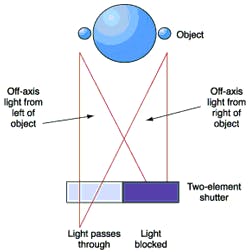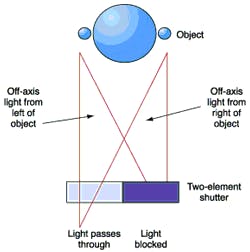3-D shutter offers single-lens stereo
[email protected]
In gastroenterology, physicians often use endoscopes to directly examine organs of the intestinal tract. When using these instruments in conjunction with surgical instruments during an operation, for example, doctors can perform biopsies while viewing images of the anatomy of the gastrointestinal tract in real time.
Whereas such imaging devices produce clear images, they mostly use a single CCD camera to provide color images.
In most applications, the produced images lack depth information. Consequently, the physician cannot easily judge the distances of the organs from a surgical instrument. To overcome this limitation, companies such as StereoImaging (Tyngsboro, MA) are developing compact single-housing stereo cameras that can capture and display stereo images on standard monitors and autostereoscopic and head-up displays (see Vision Systems Design, July 2001, p. 7).
Moreover, CRL Opto (Hayes, Middlesex, England) has developed an elegant (although more expensive) imaging platform that adds stereo capability to such surgical applications with fast-switching ferroelectric-liquid-crystal (FLC) shutters. The patented technology uses a multielement FLC shutter that helps capture stereo images from a single monoscopic camera.
During operation, the two-element shutter in the camera's iris plane is switched from one element to another in less than 100 µs. Because the switching element rate is greater than 25 Hz, the shutter can be used with standard PAL-based CCD cameras where the 312 horizontal lines in each frame are refreshed at 50 Hz (25 Hz per field).
"In operation, off-axis light from the left part of the scene predominantly passes through the right half of the iris plane, while off-axis light coming from the right part of the scene predominantly passes through the left part of this plane," says Paul Surguy, director of research and development at CRL Opto. When the right shutter element is shut and the left element is open, off-axis light from the right of the object is transmitted and off-axis light from the left part of the object is blocked. When the right shutter element is open and the left element is closed, off-axis light from the left of the object is transmitted and off-axis light from the right part of the object is blocked.
In an interlaced PAL video camera, the shutter has one element open during the odd frame and the opposite element open during the even frame. Therefore, the right and left images are contained in the odd and even frames of the video signal. As the field sequential signal is PAL-compatible, it can then be displayed on standard PAL broadcast-type monitors. To display three-dimensional video in real time, however, the fields must be successively switched at 25 Hz per field and viewed through devices such as the NuVision 60GX IR synchronized glasses from McNaughton (Beaverton, OR).
Like the SC-10 stereo camera from StereoImaging, however, this switching technique can cause flicker that may be unacceptable to the observer. "To overcome this problem," says Surguy, "output from PAL cameras used with the shutter can be displayed on a 100-Hz frequency-doubled monitor. To display images on such monitors, even and odd frames are read into a frame buffer at 25 Hz per field. After the images are stored, they are read from the frame buffer at 50 Hz per field and displayed in an interlaced format on a 100-Hz monitor. "In this way," says Surguy, "the observer perceives a frequency-doubled stereo image that is flicker free."

